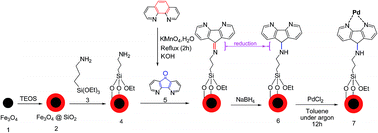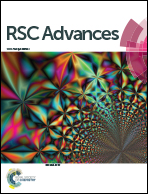C(sp2)–C(sp2) cross coupling reactions catalyzed by an active and highly stable magnetically separable Pd-nanocatalyst in aqueous media†
Abstract
A new magnetite Pd-nanoparticle supported (4,5-diazafluoren-9-one)-derived palladium chloride (7) was synthesized, characterized and introduced. The nanocatalyst exhibited an efficient activity in Suzuki cross-coupling reactions with an environmentally-friendly (H2O/DMF) solvent system for 1–3 h at 100 °C and Mizoroki–Heck cross-coupling reactions. The catalyst can easily be recovered from the reaction system by using an external magnet and reused several times with high yields.


 Please wait while we load your content...
Please wait while we load your content...